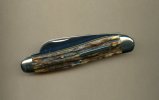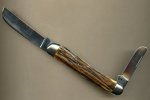-
The BladeForums.com 2024 Traditional Knife is available! Price is $250 ea (shipped within CONUS).
Order here: https://www.bladeforums.com/help/2024-traditional/
You are using an out of date browser. It may not display this or other websites correctly.
You should upgrade or use an alternative browser.
You should upgrade or use an alternative browser.
"Made in Sheffield" 1830-1930, A golden age ?
- Thread starter wellington
- Start date
- Joined
- Oct 11, 2001
- Messages
- 3,739
Nice score Lee! Thanks for posting it. Looking forward to future posts by you in this thread.
Will Power
Gold Member
- Joined
- Jan 18, 2007
- Messages
- 33,576
L
LongBlade
Fascinating examples but also challenging-the intricacy of the Tortoiseshell knife is impressive but why so small? Just to prove the cutler's skill? It's like a miniature Sportsman's Knife so perhaps it was for an elegant Lady or even a wealthy child? The address of the vendor Billiter St may have been a well heeled street, it is part of the colossus of the City of London finance centre today and is a place of glass towers, Diamonds as Big as the Ritz with the London Gherkin just up the road. Do you think it's EC and not ES, as that's the London district it's in EC? Billiter St. was also a place where bells were cast as there were many churches in the vicinity, long ago of course but it gives a metal working connexion.
with the London Gherkin just up the road. Do you think it's EC and not ES, as that's the London district it's in EC? Billiter St. was also a place where bells were cast as there were many churches in the vicinity, long ago of course but it gives a metal working connexion.
The Ivory Sportsman is larger than life as is fitting for the pattern but being hafted in Ivory seems strangely impractical. Yes, it was a costly item aimed at the likes of would be country gents or toffs about town so Ivory would add to the lure, but it's hopelessly fragile stuff for a large knife that could expect to see some rough or at least 'enthusiastic' work. Usually Stag would be the order of the day, ribby,grippy and more durable than bone or horn yet giving a luxurious touch too. Your knife might well have been a lavish present from a doting mother, a proud wife or amorous mistress who wanted to give a luxurious gift and demanded Ivory perhaps not knowing its fragility ? It is also suitable for monograms, work more usually found on metal possessions or jewellery. The letters are confusing, I'd recommend showing it to a professional engraver, there can be dozens of fonts and styles with monograms rendering them incomprehensible to the untrained eye. In a moment of wild speculation I even wondered if they were Cyrillic letters and that the knife was for a Russian, Serb or Bulgar owner Could be YA K R but it's not
Could be YA K R but it's not It's as though the first letter/number was unfinished..maybe the Ivory cracked under the engraver's tool?
It's as though the first letter/number was unfinished..maybe the Ivory cracked under the engraver's tool?
Looking forward to seeing more of your excellent and genuinely interesting knives.
Thanks, Will
The Ivory Sportsman is larger than life as is fitting for the pattern but being hafted in Ivory seems strangely impractical. Yes, it was a costly item aimed at the likes of would be country gents or toffs about town so Ivory would add to the lure, but it's hopelessly fragile stuff for a large knife that could expect to see some rough or at least 'enthusiastic' work. Usually Stag would be the order of the day, ribby,grippy and more durable than bone or horn yet giving a luxurious touch too. Your knife might well have been a lavish present from a doting mother, a proud wife or amorous mistress who wanted to give a luxurious gift and demanded Ivory perhaps not knowing its fragility ? It is also suitable for monograms, work more usually found on metal possessions or jewellery. The letters are confusing, I'd recommend showing it to a professional engraver, there can be dozens of fonts and styles with monograms rendering them incomprehensible to the untrained eye. In a moment of wild speculation I even wondered if they were Cyrillic letters and that the knife was for a Russian, Serb or Bulgar owner
Looking forward to seeing more of your excellent and genuinely interesting knives.
Thanks, Will
Campbellclanman
Platinum Member
- Joined
- Mar 10, 2007
- Messages
- 15,820
Will - interesting my friend, I think in the Day Ivory wasn't the elite handle material by any means, Now-a-days we tend to beef up the price of Ivory because of the complete turn around of circumstances and unavailability of Ivory because of good reasons, but there were rooms literally full of Ivory in the day.
I think more so the Tortoise Shell that had Gold Leaf behind to amplify the effect of the Translucent Shell Colours, but most certainly when these Knives came out Pearl was THE most expensive Handle material one could use. It was extremely interesting when Jack Black and I visited Stan Shaw - man we were SO lucky as we spent a long time in Stan's workshop and one part I remember very well was Stan telling us about just how Pearl Handle Material was so so difficult to use as you could crack it if not onto your game- and the way he expresses to us how you did NOT want to do that in the Shop in those days as it was so horrifically expensive for the shop to obtain these materials.
Also in the day there were so many other utensils with ivory, statues for Africa ( sorry for the pun ), Tableware, even Button hooks for Gloves etc.
We see Ivory crack nearly all the time, as we could only imagine how tight and well fitted Ivory Handles are, but with Humidity conditions and Moisture etc- will often lead to Ivory Cracking, as the pins dont move, perhaps 50 years after the fact.
I think more so the Tortoise Shell that had Gold Leaf behind to amplify the effect of the Translucent Shell Colours, but most certainly when these Knives came out Pearl was THE most expensive Handle material one could use. It was extremely interesting when Jack Black and I visited Stan Shaw - man we were SO lucky as we spent a long time in Stan's workshop and one part I remember very well was Stan telling us about just how Pearl Handle Material was so so difficult to use as you could crack it if not onto your game- and the way he expresses to us how you did NOT want to do that in the Shop in those days as it was so horrifically expensive for the shop to obtain these materials.
Also in the day there were so many other utensils with ivory, statues for Africa ( sorry for the pun ), Tableware, even Button hooks for Gloves etc.
We see Ivory crack nearly all the time, as we could only imagine how tight and well fitted Ivory Handles are, but with Humidity conditions and Moisture etc- will often lead to Ivory Cracking, as the pins dont move, perhaps 50 years after the fact.

 .. You bring up some good points Will -
.. You bring up some good points Will -In terms of the Clements knife I think it was most likely made for a lady or gentleman - a small but fancy accoutrement for the wardrobe
 ..
..I understand your view regarding the ivory on the Jenner & Knewstub - if you look in Flook's book you will see the same knife in ivory except instead of a hoof pick there is an awl - but ivory for sure. IMO that suggests that the knife was not a special custom - definitely I agree the "norm" for sportsman's knives was/is stag. No doubt despite the abundance of ivory (the Rodgers Ivory room always comes to mind) it was considered a higher end fancy handle (especially when MOP was not a possibility) - exhibition knives of the period had high end stag, ivory or MOP. I'm not sure if I am correct but my impression has been ivory is fairly durable as is stag - and we do find chips and cracks in both handles on old knives - though stag was used on field knives there were other examples of ivory especially on larger jack knives (and perhaps not the same but the handles of many Bowies were also ivory). MOP is no doubt the most fragile imo - and unfortunately MOP cracks and chips really stand out... I also think whether this handle was stag or ivory there would have been chips in the same place - I am guessing that because the hoof pick is so tight that somebody lost their patience and hammered away at it to get it opened
 - I'll see if I can find a local professional engraver (or perhaps email one the photo).
- I'll see if I can find a local professional engraver (or perhaps email one the photo). - ivory was a more common material and MOP was the top of the pile. Even there I have seen some fairly large handles of MOP... I have a big MOP tear drop jack (Southington made which I think I posted under the old knives thread) and I've seen MOP even on a cattle knife
- ivory was a more common material and MOP was the top of the pile. Even there I have seen some fairly large handles of MOP... I have a big MOP tear drop jack (Southington made which I think I posted under the old knives thread) and I've seen MOP even on a cattle knife
Last edited:
- Joined
- Oct 11, 2001
- Messages
- 3,739
Lyle, the good news is that it didn't require mouth to mouth!
Campbellclanman
Platinum Member
- Joined
- Mar 10, 2007
- Messages
- 15,820
Corso- Great Rodgers Jacks - love the Stove Pipe Kick on the Ebony / Horn example at bottom.
Robeson- exquisite example of Sheffield Master Cutlery there.
Robeson- exquisite example of Sheffield Master Cutlery there.
Corso- Great Rodgers Jacks - love the Stove Pipe Kick on the Ebony / Horn example at bottom.
Thanks its Ebony wood
wlfryjr
Gold Member
- Joined
- Oct 20, 2011
- Messages
- 1,980
Thought I would repost this knife in a few places to get other opinions. I find the master blade a Sheffield peculiarity.I thought at first ,someone might have altered a pruning blade, but upon inspection the kick doesn't appear to be altered. This would have to be done to allow the blade seated inside the framework.
Normal farmers jacks with this blade edge would peek out above the frame. Opinions, insights.



Normal farmers jacks with this blade edge would peek out above the frame. Opinions, insights.



Will Power
Gold Member
- Joined
- Jan 18, 2007
- Messages
- 33,576
A very attractive & interesting variant, by the look of the construction and Stag, from the Quality Era so I'd make a wild guess at Edward VII 1901-10. Is it all steel or brass liners?
Thanks, Will
Thanks, Will
Old Engineer
Gold Member
- Joined
- Nov 30, 2014
- Messages
- 10,078
Old Engineer
Gold Member
- Joined
- Nov 30, 2014
- Messages
- 10,078






